What Is a Protective Relay?

A protective relay is a device that instantly detects sudden changes in current and voltage occurring in power system equipment and sends a control signal to the circuit breaker to isolate the faulty point.
By quickly disconnecting the faulty part in the event of an accident in the power system, the protective relay not only prevents the spread of damage caused by overcurrents but also minimizes the duration of power outages and ensures a stable supply of electric power.
For this purpose, equipment fault elimination relays to isolate faulty equipment and accident spread prevention relays to prevent the spread of the effects of accidents are dispersed throughout the power system. A reclosing device for quick recovery from an accident is also treated as a type of protective relay.
Uses of Protective Relays
Protective relays are used to prevent the effects of accidents such as lightning strikes from spreading throughout the power system and to ensure a stable supply of electricity. Protective relays are installed in various places in facilities that make up power systems, such as power plants, substations, and power transmission and distribution lines managed by power companies.
Private power generation facilities that are connected to the power company’s power system are also required to install protective relays at the receiving points to protect the power system in the event of a failure of the private power generation facilities and to protect the private power generation facilities in the event of an accident on the power system.
In addition to power generation facilities, protective relays are also used to protect power receiving and transforming facilities in buildings, factories, hospitals, railroads, and other power-demand facilities.
Principle of Protective Relays
The operational principle of protective relays varies depending on the type of protective relays.
Over Current Relay (OCR): Operates when the current value at the location where the protective relays are installed exceeds the set value. There are two types of elements that trigger the overcurrent protective relays: dimensional elements and instantaneous elements. The dimensional element operates when it detects that an overcurrent has flowed for a long period of time due to an overload. The higher the current value, the sooner the normal system is protected. The instantaneous element detects the instantaneous flow of a large current far in excess of the rated current due to a short circuit and protects the normal system.
Over Voltage Relay (OVR): Operates when the voltage at the location where the protective relays are installed exceeds the set value. Detects overvoltage on the power system side due to a generator or other failure and protects the system and equipment on the load side.
Under Voltage Relay (UVR): Operates when the voltage at the location where the protective relays are installed drops below a set value. Detects a drop in power due to a power failure or short-circuit failure, and protects the load-side system and equipment.
Ground Fault Protective Relays (GR: Ground Relay): Operates by detecting ground faults caused by cables contacting the earth. Ground protective relays use a zero-phase alternator (ZCT) to detect unbalanced current due to an imbalance in the three-phase circuit in the event of a ground fault. At this time, since a ground fault is detected only by the magnitude of the current, it is not possible to distinguish between an accident current in the power system and an accident current on the self-circuit side, which may result in false detection.
Directional Ground Relay (DGR): Operates by detecting a ground fault using the zero-phase current and zero-phase voltage between the line and the ground. It can detect only the fault current of its own line in the direction of the phase difference between the current and voltage.
Differential protective relays (DFR: Differential Relay): Operates when the differential current, which is proportional to the vector (current value and phase) difference between the input and output currents in the protective section, exceeds a certain value. Only when a short circuit occurs in the protective section, a difference is generated in the secondary current of the alternator (CT), and a differential current flows to the operating coil. With this method, the differential current does not reach zero during normal operation due to the characteristic difference of the CT, etc., and may malfunction.
Ratio Differential Relay (RDFR): To prevent malfunction of the differential protective relays, differential protective relays have a structure with an additional suppression coil that generates a suppression force when a current passes through it. When a large current due to an external accident passes through the relay, a large suppression force is applied to prevent malfunction.
Other types of protective relay systems include power protective relays, over-frequency protective relays, under-frequency protective relays, short-circuit protective relays, and short-circuit direction protective relays.